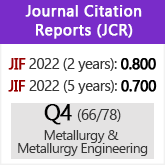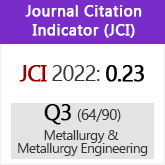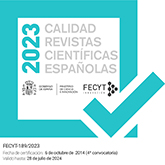Influence of the microstructure on the fracture toughness of forging microalloyed steels
DOI:
https://doi.org/10.3989/revmetalm.1996.v32.i3.912Keywords:
Microalloyed steels, Thermomechanical treatments, Mechanical properties, Toughness, Microstructure, Acicular ferriteAbstract
The influence of thermomechanical treatments, first carried out at laboratory and afterwards on an industrial scale on the mechanical properties of microalloyed forging steels is analysed. The influence of hot working conditions and the cooling rate after hot working on both the strength and the toughness is analysed. Optimization of the thermomechanical treatments parameters has been carried out at laboratory and the optimized schedules have been carried out industrially. The actual experimental results of mechanical properties have been rationalized in terms of the microstructure developed during the different thermomechanical treatments. After slow cooling of steel bars hot rolled at low temperature (below 850 °C), the ferrite-pearlite is much refined and the toughness improved. Alternatively, accelerated cooling after hot working at high temperature produces a microstructure of acicular ferrite with improved toughness.
Downloads
Download data is not yet available.
Downloads
Published
1996-06-30
How to Cite
Romero, J. L., Linaza, M. A., San Martín, J. I., Rodríguez-Ibabe, J. M., & Urcola, J. J. (1996). Influence of the microstructure on the fracture toughness of forging microalloyed steels. Revista De Metalurgia, 32(3), 167–179. https://doi.org/10.3989/revmetalm.1996.v32.i3.912
Issue
Section
Articles
License
Copyright (c) 1996 Consejo Superior de Investigaciones Científicas (CSIC)

This work is licensed under a Creative Commons Attribution 4.0 International License.
© CSIC. Manuscripts published in both the printed and online versions of this Journal are the property of Consejo Superior de Investigaciones Científicas, and quoting this source is a requirement for any partial or full reproduction.All contents of this electronic edition, except where otherwise noted, are distributed under a “Creative Commons Attribution 4.0 International” (CC BY 4.0) License. You may read here the basic information and the legal text of the license. The indication of the CC BY 4.0 License must be expressly stated in this way when necessary.
Self-archiving in repositories, personal webpages or similar, of any version other than the published by the Editor, is not allowed.

















